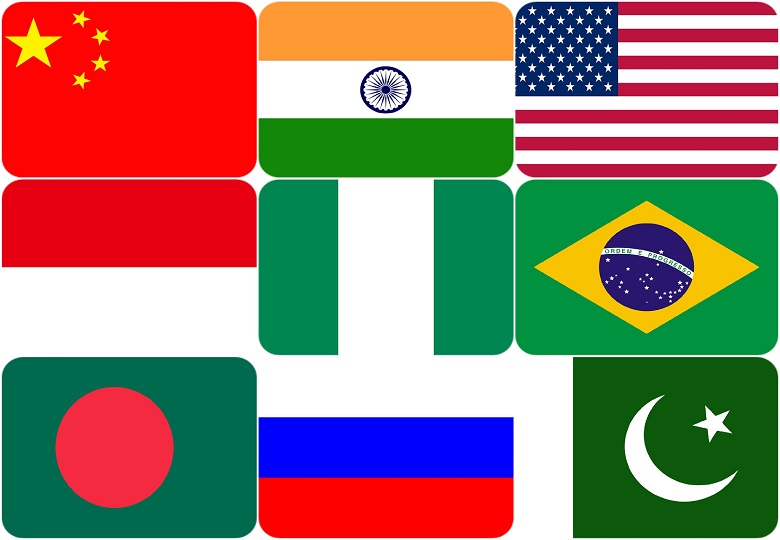Did you know that only ten countries are home to more than 4 billion human beings? Another incredible fact is that the number of living humans is greater than the cumulative number of dead in all human history.
But which are these countries with the most inhabitants in the world? Which are the most populous countries on the planet?
The top 10 most populous countries on the planet
1. China

The most populous country in the world is, therefore, China, with 1,441,800,000 inhabitants. This figure is impressive because it is almost a fifth of the world’s population. For several decades, China has tried to curb its demographic growth, mainly through a stringent birth rate policy: the one-child policy.
But this birth rate policy has also led to distortions in the male/female relationship and has posed other problems on the economic level. Because the replacement of generations no longer ensures, there was a risk of workforce shortage. But there was a change in 2015; after 36 years of the one-child policy, the Chinese can now have a second child.
2. India
At the top of the most populous countries is India, which is in second place. India is, therefore, the second-most populous country in the world with 1,391,096,970 inhabitants. And demographers agree that India could perhaps become the most populous country on the planet within a few years ahead of China.
3. United States
The United States has a population exceeding 328,239,523. (2019 estimated figures). American demography has specificities directly linked to its history and geography.
On the one hand, the United States is the first country globally in terms of net migration. On the other hand, its population began around the 17th century.
The United States is the third top populated country in the world. Above all, the country has the highest GDP globally, which ranks the United States with the wealthiest inhabitants. So that’s what makes it the most powerful country in the world.
4. Indonesia
There are 270,203,917 inhabitants in Indonesia spread over 1.9 million km² on nearly 10,000 islands. That is to say, a density of 137 inhabitants per km². Demographic studies show a fertility rate of around 2.6 children per woman.
From two children per woman, the population replaces. So this rate of 2.6 suggests very logically that the Indonesian people will continue to grow steadily and rapidly in the coming years. As a reminder, Indonesia is the largest Muslim country in the world.
5. Nigeria
This African country has 206,630,269 inhabitants. Nigeria is the most populous country in Africa and occupies 7th place among the most populous countries in the world.
But with a very high birth rate and high demographic forecasts, everything suggests that the population will continue to grow in the future.
6. Brazil
Brazil still has 210,147,125 inhabitants. It is the biggest and most populated country in all of South America. Brazil is also the 5th largest country on the planet.
The density in Brazil is 24.1 inhabitants per km². The country nonetheless covers 8,547,877 km² and has on its territory one of the most extensive forests on the planet: the Amazon.
7. Pakistan
Pakistan has 208,570,000 inhabitants. (2020 estimate population). With a fertility rate of 3.8 offspring per woman, Pakistan’s population is expected to double by 2050.
But it should still note that the vast majority of the population, unfortunately, lives in a situation of extreme poverty. The density estimate at 240 inhabitants per square kilometer. The country covers 796,096 km2. The life expectancy was around 66 years. (2014).
8. Bangladesh
Bangladesh has 162,000,000 inhabitants (2018 estimates), which places it in eighth place among the most populous countries in the world. If we exclude tiny countries such as Monaco or Bahrain and Singapore, Bangladesh is the most densely populated country globally.
9. Russia
Moscow, the capital of Russia one of the most populous countries in the world. The largest country in the world has 146,171,015 inhabitants. Another impressive figure, nearly three-quarters of its inhabitants live in cities. The rate of urbanization is therefore exceptionally high, with a figure of 74%. Moscow, Saint-Petersburg, Ekaterinburg, Novosibirsk are the largest cities in Russia in terms of inhabitants.
In 1991, the Russian population reached an all-time high of 148,689,000 inhabitants, just before the break-up of the USSR. Then for twenty long years, Russia will “lose” every year a massive number of inhabitants. Because deaths in Russia are more numerous than births, there is, therefore, a negative balance. This phenomenons also amplify by the flight of residents to the West during the collapse of the Soviet bloc in 1991.
But in recent years we can observe a slight demographic reversal, natural increase has started to rise again. On the other hand, Russia occupies first place in terms of surface area. It can be proud of the title of the largest country on the planet, with a territory of more than 17 million square kilometers.
10. Japan
The archipelago of 11,000 islands is populated by 125,798,426 people, making it one of the most populous countries in the world.
Apart from this good ranking, Japan has one of the highest population density rates per km² in the world. The density is therefore 335 inhabitants per km2. The country covers 377,972 km2. Life expectancy there is 83.4 years, and it is one of the highest in the world.
The fertility rate is 1.4 children per woman (2015). Japan, therefore, occupies a tenth place in the list of the most populous countries in the world.
